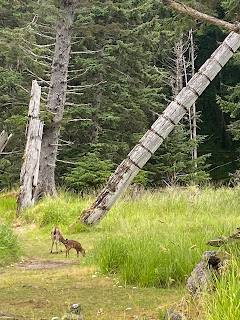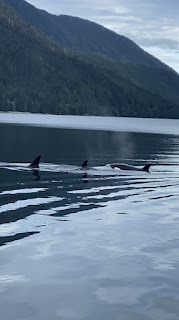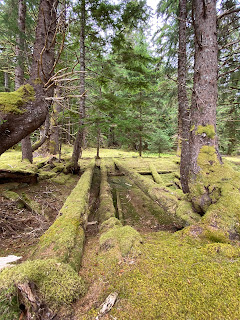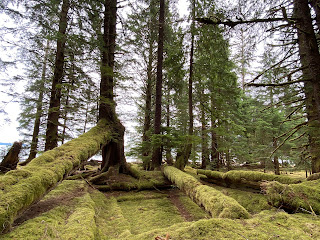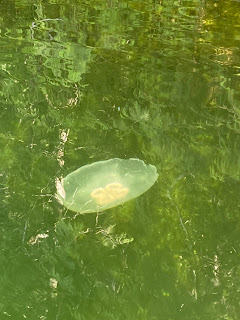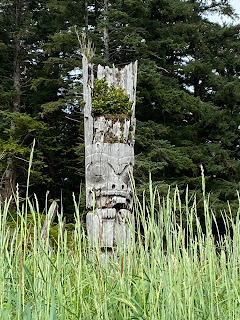The Haida people, fierce warriors of the coast and slave to no other tribe were brought down by the dreadful power of Smallpox that was unleashed with the coming of the white man. They had no immunity and died terribly in mass numbers. It was a society-wrecking apocalypse and no one, including the rare white settler who cared, could do a thing to stop the collapse of a culturally advanced nation of people. All over North and South America it was the same. Waves of Smallpox and Influenza wiped out indigenous populations with fatality rates of up to 97%, all at the same time as the war mongering and arrogant invaders cared nothing for the indigenous people they usurped, taking all they had, virtually without compunction. The spiritual beliefs of so called savages were deemed inferior to the Christian god of the invaders, though oddly, under the guise of “preservation of culture” the artifacts of the savages were happily stolen for installation in the white man’s museums.
This could be a polemic on the injustices of colonialism, or a diatribe on the ingrained cruelties of the human condition, but really it is simply observational: world views differ and are changed by the lens of the observer. What seems objective from one sight line often seems ridiculous when seen by another angle. Our cultures and our histories inform us in ways that invisibly melt into our sensibilities. The injustices suffered by the people of our own perceived kind perpetuate themselves in repeated acts of bloody warfare and insurrection. Whatever human kindness we natively possess is in the moment subordinated to the cross-generational grievances of our identity.
This is not to say that there exists no human truth at all, but at the minimum, honest contact with people of divergent cultural belief systems has a way of changing the colour tone of our observational lens. No more so is this true than when pausing to acknowledge artistic beauty. Discordant though our beliefs systems may be, and though we may not understand its symbolism, a work of art has the power of influence. The idea of “savage” has no concordance with the necessarily advanced capabilities of the culture present when that great art was created. And if that is true, what else of that culture may we have misconstrued?
In the past three generations the Haida people have experienced a resurgence of their population, identity and pride. The essential remnants of their previous cultural and social structure have been passed through the generations and have forcefully re-emerged. The traditional art of the Haida people is powerful on its face and it is also now famous worldwide. Within Canada,the social recognition of that fact has ever so slowly assisted in the re-assertion of Haida political power and influence. In the 1970’s the Haida people protested against the unsustainable rates of old-growth logging that were taking place on their traditional territories. To the great benefit of all humans, their efforts were grudgingly acknowledged. In 1993, after a lengthy struggle, a co-management agreement was established to create the Gwaii Haanas National Park Reserve and Haida Heritage Site. Adventuring tourists, kayakers and sailors such as us are the lucky beneficiaries. For it is not just Haida art that is beautiful, but also the place itself.
Our trip plan through Gwaii Haanas was north to south. We took a favourable weather window and left Daajing Giids on Monday morning. This was a little unfortunate because on Sunday everything is closed, both in town and where the museum and seat of Haida government is located, at nearby Skidegate. So having arrived late on Saturday we missed visiting that. Still, a good weather window is not to be looked at in the mouth. Setting off in the flat calm conditions of the early hour, we re-crossed the Skidegate Bar and with the coming of daytime winds to help sail us, turned southward.
First stop was the most northerly of the Haida watch-keeper sites, Skedans (K’uuna Llnagaay). We tied up to a brand new buoy complete with a shiny chain and radioed VHF channel 06 for permission to go ashore, joining a group of seven kayakers who had arrived at the same time as us. Our tour guide was an engaging woman. In appearance she was humbly dressed and with prominent bad teeth. Telling her story it became evident that the archeological particulars of the site were not her strong suit; to that she admitted inexperience and lacked training, by her bosses left to her own devices. The problem was that the availability of watchmen staffing, and of funds, was short this year. Still, she had a book with diagrams and pictures she referred to that assisted our understanding of the decaying ruins that lay before our eyes. But what made her an interesting and rewarding guide was that which we could neither see nor hear was to her Haida comprehension not at all invisible. As we walked alongside the rotting longhouse ruins on the path, she pointed out the names of all the small plants and lichens. She showed us how Sitka Spruce thrived growing on the decay of fallen cedar logs. And as she spoke of mortuary poles it became clear that for her the spirits of Haida were all about us, the dead living among the alive. Her family were of the Raven clan and once, visiting a burial site of the Eagle clan, a rock had mysteriously flown out of the trees, landing at her feet; the spirits of a past feuding Eagle generation demonstrating their disapproval at the presence of a Raven. At Skidegate, in the museum near where the mortuary poles once stood, she told of hearing the chattering voices of children and wondering where they were – but checking the premises none in physical form were actually present. In the places where we walked, the murmurs of the dead - friend and foe - could be heard in the forest at night time. Sometimes it was scary hearing it. But always, when it was the sounds of children, they were sounds of happy play.
After our tour of Skedans we anchored at Rockfish Harbour, alone once again in the quiet wilderness. While looking over the side at the huge orange jellyfish floating nearby, the unmistakable “phhst” sound of whale-breath could be heard. Alice, whales, come see! Look there, 50 metres away, another spout, then two, three, four. A family group of Orca were swimming directly towards our anchored boat: two adults, a newborn and another young one, perhaps a year older. Magic of another kind was appearing before our lucky eyes. The water was crystal clear and under the water we could see their black and white profiles as they dove in front of our bow and directly under our boat, heading away out of the inlet, elegantly cruising in search of their salmon prey.
The trip to Tanu Watchmen Site (T’aanuu Llnagaay) was 25 miles and we motored slowly while fishing. Line strike, good one! Reeling it in, the bald eagle saw it too and swooped down to take it, claws reaching out and forward. The fish saw death from capture and also from above; but the eagle saw a boat too close for comfort and at the last moment abandoned her swoop. As we brought the fish within reach of the net it got away, yet another one lost to luck and to our fishing incompetence. An hour later with the binoculars Alice spied a bear turning over rocks at a river outlet. Motoring over to have a closer look, we should have reeled in the lines. We wanted to get as close as possible and then drifted too near the shore. Damn, that’s the bottom, turn quick! Crap and snap, there goes the nice red minnow lure.
The guide at Tanu was a very knowledgeable woman who met us along with her little girl, who cutely hissed at us as we walked up the beach. “I’m Poison Ivy”, she said. “That’s not her real name”, said mom. “Be nice!” She was three years old and mom and husband were on a lengthy May-Sept posting. Over the course of the summer two older children would also be coming and going out of Skidegate. The watchers of Haida Gwaii are re-provisioned every two weeks and it must be hard standing so long a watch while each day, again and again, telling the story of the site. At Tanu the remains of numerous longhouses can be seen, with house beams and fallen frontal and mortuary poles slowly rotting in the forest. Barely visible in the mossy decay could be seen the final remaining remnants of carvings on the fallen poles. It is in the Haida tradition that just as the memories of past generations are lost to time, poles that fall and rot eventually fade from human memory.
That night we shared an anchorage at Echo Cove with Nomad, an Austrian flagged boat whose owners turned out to be good friends with the owners of a boat called Astrolabe, who we had met in Chiapas, Mexico, just as Covid was descending on the world in early 2020. Nomad had transited the Northwest Passage east to west in 2016, a remarkable achievement that they brushed off as non-consequential.
Twenty miles past Echo Bay, at the Windy Bay site (Hlk’yah Gaawag) there is a marvelous carved story pole that was erected in 2013 to mark the 20th anniversary of the agreement that established Gwaii Haanas as a park. Our main guide was a man who introduced himself as Gordy, but joining the presentation and standing with the support of a long wooden pole to assist his bad knee was a man called Colin. Gordy explained the figures, their symbolism and the story told by the carvings on the pole and Colin, speaking with considerable forcefulness, told the political story of how the park came to be established, along with an expression of continuing grievance that the park was being co-managed on lands that had never in the first place been conceded. His speech causing a dim remembrance from nearly forty years previous, Greg asked Colin what was his full name: Colin Richardson. “Related to Miles Richardson, by chance?” Yes, his brother. “Funny thing”, I told him, “I met you once forty years ago while giving a presentation on aquaculture to the band council at Skidegate.” We chatted a little, with me naturally remembering Colin much the better than he me, if he at all. Back then Miles and Colin were strong speakers who projected a fiery political presence, making not only waves but also the daily news. Colin, though perhaps mellowed a little by time, remains the same today.
After getting stinky for two weeks on a boat, who wouldn’t want a soak in a nice hot bath? Hot Spring Island (Gandll K’inGwaay.yaay) is a stop not to be missed. We anchored two nights at Murchison Island and on the first morning took our dinghy for the 3 NM ride to the trail head which is hidden in the beach-front bush. All the watch keeper trails hereabouts are marked by clam shells, but the hot springs trail as it winds through the woods has a vibe that especially feels like one that will surely end at a candy-coated house. At the cedar beam-and-plank buildings that serve as quarters for the watch keepers we were met not by a witch, but by Doug and Tuna, who were serving a two-week stint on the island as a rotation crew. They were extremely friendly and as Alice did not fail to note, both super good looking men, made even more attractive by the arty “Haida-modern” tattoos on their arms and faces. An earthquake in 2012 had temporarily shut off the water flow to the pools but ten years later the flow had returned in fine form to serve us. Just like the bowls of the three bears, the pools could be described as too hot (44C), perfect (40C) and a little too cold (35C), but the views from each of the pools were every pot smoker’s dream.
On our meandering way to visit the final Watch keeper’s site we enjoyed three nights at peaceful anchorages: at Sac Bay with its tall rocky sides and rustling mountain streams; Section Cove, with its deer swimming across our bow as we arrived and its rummaging black bear on the shore; and Ikeda Cove, with a herd of 14 deer grazing on the grassy river meadows ashore.
The 15 miles to Rose Harbour were a little on the wet side and we wore red on deck, suited up in our foulies. Up to then we had little rainy weather on our trip but that day it stayed dark and misty until nightfall, giving the decks a good soaking.
As we set off for Anthony Island (SGang Gwaay), better weather greeted our morning. Previously known as “Ninstints” (a corruption of a chief’s name, which was actually “Nan Sidins”), it is the most famous place in Gwaii Haanas and in 1981 became a UNESCO World Heritage Site. We anchored in a small rocky cove to the southeast of the heritage village and paddled from the boat in our inflatable kayaks to the beach to meet with our guide, Reg. He was stationed there on a 4 month posting, along with two archaeologists and another watchman. During the summer the island had been the subject of an archaeological study and earlier in the season there were as many as 8 investigators participating in the dig.
What can be said of SGang Gwaay that isn’t better said with photographs or by those with more expertise than we? The totems standing at the site are primarily mortuary poles, because museum sleuths had in the mid 1900’s cut down and taken away almost all of the longhouse frontal poles to museums around the globe. The Haida pass on their family lines on a matriarchal basis and the ownership of crests are held as a sacred trust of entitlement that is not to be broken. Carvings on the poles, with specific crests depicted, can therefore be used to track the lineage of the Haida highborn. It was also interesting to hear about the impact of the steel brought by the trading invaders on the pole carving techniques. Pre-contact, using shells and stone as chisel tools, carvings tended to be shallower with less depth.
The Haida dead were interred above-ground, not buried. Mortuary poles, in boxes at their top, once held the remains of the Haida elite, such as chiefs or others from the high families. Not being quite as tall or impressively carved as house frontal poles, and perhaps out of some vestige of respect (or more likely fear) the mortuary poles were less likely to be stolen away from the site by collection raiders. All the dead were tended to by Shamans, who oversaw the decomposition process until it was bones alone remaining. The bones of ordinary folks such as ourselves were held in grave houses. No pole tops for the likes of us! Then, as now, we all get what we deserve, or possibly that’s not true and we don’t. But what is certain is that a trip through Gwaii Haanas on our sailboat was a special privilege that will live on in our memories until we too are dead.
Skedans (K’uuna Llnagaay)




